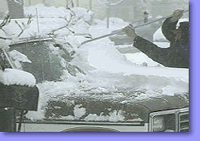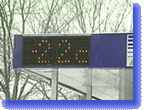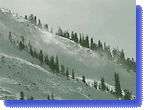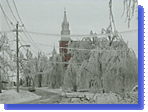W I
N T E R S T O R M S
 Winter
storms are potentially deadly combinations of extremely cold temperatures, freezing
precipitation, and strong winds. But these ice and snow storms kill indirectly:
70% of the deaths that occur during winter storms happen when motorists try
to navigate icy streets in low visibility, and 25 percent are the result of
hypothermia, the condition where a person's body temperature is dangerously
decreased from exposure to the cold. Also at risk are people who shovel large
amounts of snow or walk considerable distances in the snow: both are susceptible
to heart attack, and both activities can cause sweating, which heightens the
risk of hypothermia and frostbite.
Winter
storms are potentially deadly combinations of extremely cold temperatures, freezing
precipitation, and strong winds. But these ice and snow storms kill indirectly:
70% of the deaths that occur during winter storms happen when motorists try
to navigate icy streets in low visibility, and 25 percent are the result of
hypothermia, the condition where a person's body temperature is dangerously
decreased from exposure to the cold. Also at risk are people who shovel large
amounts of snow or walk considerable distances in the snow: both are susceptible
to heart attack, and both activities can cause sweating, which heightens the
risk of hypothermia and frostbite.
The
amount of damage a winter storm causes is largely dependent on where it hits
and how well-prepared people are.. Winter storms are normally characterized
by extreme cold, either during the storm or immediately in its wake, but the
definition of extreme cold varies from climate to climate. In warmer regions,
a low temperature of just about freezing can destroy crops or cause pipes to
burst where there is poor insulation. In colder places, persistent temperatures
below zero can cause rivers to ice over and create ice jams, a situation that
may trigger a flood.
Wind
chill, which often accompanies a winter storm, causes temperatures to drop temperature
even lower. Wind is also responsible for some of the most dangerous conditions
that result from a winter storm: blowing snow, impaired visibility, fallen trees,
utility poles, and power lines, eroded beaches, damaged roofs, coastal flooding,
sunken ships. In hilly regions, winds can gust off mountains at speeds of 100
mph or more!
 Cold
air and wind are both necessary for the development of a winter storm. Winter
precipitation, in the form of snow, sleet, or freezing rain, is formed when
air blowing across a large body of water lifts moisture up into areas of cold
temperatures where water vapor becomes clouds of ice crystals. Sometimes this
air can be lifted by rushing up the side of a mountain; sometimes it's raised
when two air masses of varying temperature meet, and the collision forces the
lighter, warmer air mass to the top.
Cold
air and wind are both necessary for the development of a winter storm. Winter
precipitation, in the form of snow, sleet, or freezing rain, is formed when
air blowing across a large body of water lifts moisture up into areas of cold
temperatures where water vapor becomes clouds of ice crystals. Sometimes this
air can be lifted by rushing up the side of a mountain; sometimes it's raised
when two air masses of varying temperature meet, and the collision forces the
lighter, warmer air mass to the top.
An
"air mass" is a body of air that is at a constant temperature and humidity throughout.
When two masses meet, they result in a front. In the case of a warm and cold
mass colliding, a low pressure system is formed. The warm air rises, the cold
air goes under it, and the surrounding air spirals inward, causing wind. Wind
gains strength as the low pressure system gains strength. Warmer air carries
more moisture, but when the air mass gets high enough, the water vapor begins
to cool and eventually condenses into ice crystals or becomes "super-cooled"
(meaning that though its temperature is below freezing, it remains liquid).
Super-cooled droplets need only touch an ice particle to freeze themselves.
 Winter
Weather West
Winter
Weather West
An extra-tropical cyclone is usually the culprit when a big
winter storm hits, and most storms in the United States are spawned when a storm
from the Pacific Ocean moves over the West Coast. A storm may expend much of
its energy by the time it passes over the Rocky Mountains, but when it moves
east across the Plains, it gathers strength by drawing in warm, moist air from
the Gulf of Mexico and cooler, dry air from Canada.
Winter Weather
East
Winter storms on the Eastern seaboard are often called Nor'easters,
named for the northeasterly winds that precede the center of a storm. Two of
the most notorious snowstorms in the United States occurred on the East Coast.
Between March 12 and 14, the Blizzard of 1888 dumped 21 inches of snow on New
York City, and strong wind gusts created snowdrifts up to 20 feet high. Waves
on the Atlantic Ocean stood as tall as a 4-story building, and 200 ships were
either swamped or sunk. Trains stalled and trapped their passengers inside.
400 people on the East Coast died in this storm, 200 of them in New York City.
Exactly
105 years to the day after the beginning of the Blizzard of 1888 the so-called
"Superstorm" of 1993 swept over 22 states, forcing every major airport on the
East Coast to close down for the day--the first time that had ever happened--and
resulting in over $6 billion of damage.
Regional names
for Winter Weather
 Other storms and weather-related phenomena also have special names according
to region. Storms that force cold air across the Southern Plains to Texas are
called "Blue Northers." The "Pineapple Express" is a cloud corridor that begins
near Hawaii, and creates a weather pattern that gives strength to West Coast
storms. Quick storms that begin in western Canada are known as "Alberta Clippers."
A blizzard in Siberia and southern Russia is called "Purga." "Arctic Outbreak"
is the name for a record low anywhere in the U.S., and "lake effect snow" is
a phenomenon whereby cold air blowing over a relatively warm lake creates snowfall,
often in high, localized accumulations.
Other storms and weather-related phenomena also have special names according
to region. Storms that force cold air across the Southern Plains to Texas are
called "Blue Northers." The "Pineapple Express" is a cloud corridor that begins
near Hawaii, and creates a weather pattern that gives strength to West Coast
storms. Quick storms that begin in western Canada are known as "Alberta Clippers."
A blizzard in Siberia and southern Russia is called "Purga." "Arctic Outbreak"
is the name for a record low anywhere in the U.S., and "lake effect snow" is
a phenomenon whereby cold air blowing over a relatively warm lake creates snowfall,
often in high, localized accumulations.

 Winter
storms are potentially deadly combinations of extremely cold temperatures, freezing
precipitation, and strong winds. But these ice and snow storms kill indirectly:
70% of the deaths that occur during winter storms happen when motorists try
to navigate icy streets in low visibility, and 25 percent are the result of
hypothermia, the condition where a person's body temperature is dangerously
decreased from exposure to the cold. Also at risk are people who shovel large
amounts of snow or walk considerable distances in the snow: both are susceptible
to heart attack, and both activities can cause sweating, which heightens the
risk of hypothermia and frostbite.
Winter
storms are potentially deadly combinations of extremely cold temperatures, freezing
precipitation, and strong winds. But these ice and snow storms kill indirectly:
70% of the deaths that occur during winter storms happen when motorists try
to navigate icy streets in low visibility, and 25 percent are the result of
hypothermia, the condition where a person's body temperature is dangerously
decreased from exposure to the cold. Also at risk are people who shovel large
amounts of snow or walk considerable distances in the snow: both are susceptible
to heart attack, and both activities can cause sweating, which heightens the
risk of hypothermia and frostbite.  Cold
air and wind are both necessary for the development of a winter storm. Winter
precipitation, in the form of snow, sleet, or freezing rain, is formed when
air blowing across a large body of water lifts moisture up into areas of cold
temperatures where water vapor becomes clouds of ice crystals. Sometimes this
air can be lifted by rushing up the side of a mountain; sometimes it's raised
when two air masses of varying temperature meet, and the collision forces the
lighter, warmer air mass to the top.
Cold
air and wind are both necessary for the development of a winter storm. Winter
precipitation, in the form of snow, sleet, or freezing rain, is formed when
air blowing across a large body of water lifts moisture up into areas of cold
temperatures where water vapor becomes clouds of ice crystals. Sometimes this
air can be lifted by rushing up the side of a mountain; sometimes it's raised
when two air masses of varying temperature meet, and the collision forces the
lighter, warmer air mass to the top.  Winter
Weather West
Winter
Weather West  Other storms and weather-related phenomena also have special names according
to region. Storms that force cold air across the Southern Plains to Texas are
called "Blue Northers." The "Pineapple Express" is a cloud corridor that begins
near Hawaii, and creates a weather pattern that gives strength to West Coast
storms. Quick storms that begin in western Canada are known as "Alberta Clippers."
A blizzard in Siberia and southern Russia is called "Purga." "Arctic Outbreak"
is the name for a record low anywhere in the U.S., and "lake effect snow" is
a phenomenon whereby cold air blowing over a relatively warm lake creates snowfall,
often in high, localized accumulations.
Other storms and weather-related phenomena also have special names according
to region. Storms that force cold air across the Southern Plains to Texas are
called "Blue Northers." The "Pineapple Express" is a cloud corridor that begins
near Hawaii, and creates a weather pattern that gives strength to West Coast
storms. Quick storms that begin in western Canada are known as "Alberta Clippers."
A blizzard in Siberia and southern Russia is called "Purga." "Arctic Outbreak"
is the name for a record low anywhere in the U.S., and "lake effect snow" is
a phenomenon whereby cold air blowing over a relatively warm lake creates snowfall,
often in high, localized accumulations.